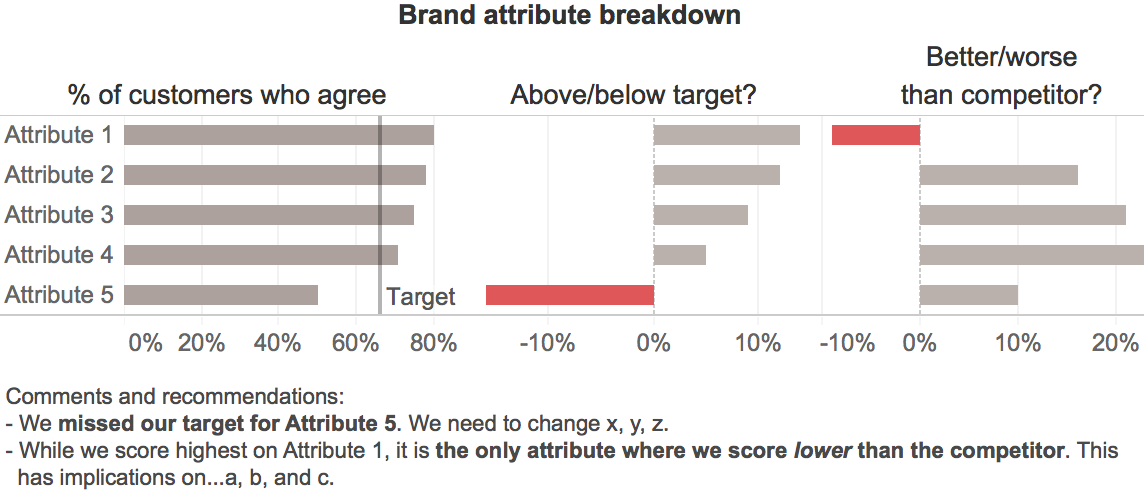I came across this recent post on Cole Nussbaumer Knaflic’s popular and highly worthwhile blog, wherein Cole proposes three redesigns of a less-than-optimal graph that a client of hers had created. I wanted to propose another, alternative redesign but, as with most blogs (including this one), I couldn’t embed an image of my redesign in a comment on her blog, so I’m posting it here instead. To understand the context and purpose of my redesign, and for the rest of this post to make any sense at all, you’ll need to read her post first. Don’t worry, I’ll wait here.
Back? Great. So, my redesign looks like this:
The main reason for this redesign was that I saw an opportunity to make the key message of the chart more visually salient and obvious. As per Cole’s description, the main message that we want to convey is that our company has two problems:
- We’ve fallen short of our target for one attribute (Attribute 5).
- Customers are rating us as worse than our competitor for one attribute (Attribute 1).
With this redesign, I think that these key messages will be understood more quickly and with less cognitive effort since much of the initial work required to interpret this graph will be done by users' unconscious visual systems, which generally begin by interpreting graphical elements before text. If we suppress the text, we can see that the key messages and many aspects of the basic structure of the data are communicated by the graphical elements alone:
Within the first second or so, and before the reader has read any text or started to consciously think about what they’re seeing, they’ll probably grasp the following basic information in roughly the following order:
- There are two problems, i.e., the two red objects. It's good that these are the most noticeable elements in the graph since they're our main message.
- Those two problems are problems because they extend to the left (i.e., are negative) while all of the other values in their respective groups extend to the right (i.e., are positive), which is an important element of the main message.
- The data consists five items (the rows), each of which has three values associated with it (the columns), i.e., the basic structure is immediately obvious.
- The items are sorted from largest to smallest, based on whatever variable is represented in the left-hand column of bars.
As the viewer starts to read the text labels, the additional understanding that those labels provide (i.e., that the data are measures of how customers feel about our company's attributes, that those measures are being compared with internal targets and responses to a competitor, etc.) falls nicely into the basic --but accurate-- framework of understanding that’s been set up by the graphical elements. This, in turn, enables what I’m guessing would be rapid and cognitively easy visual consumption and quick understanding of the key messages, though only a well-designed user test would be able to determine this with confidence.
As with almost any design, there are, of course, trade-offs. In this case, the main one is that the actual “% of customers agree” values for the competitor aren’t shown, only the differences between those values and those for our company. That was a judgment call that I made based on the assumption that the audience would care more about the differences between our company and our competitor as opposed to the actual values for the competitor, but that assumption may not be valid.
What do you think? Can you see any other problems with this redesign or can you think of a better one? If so, please pipe up in the comments.


